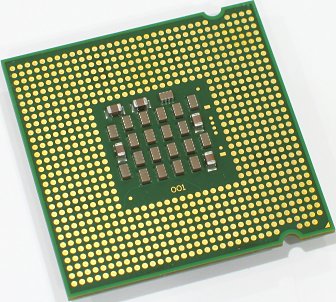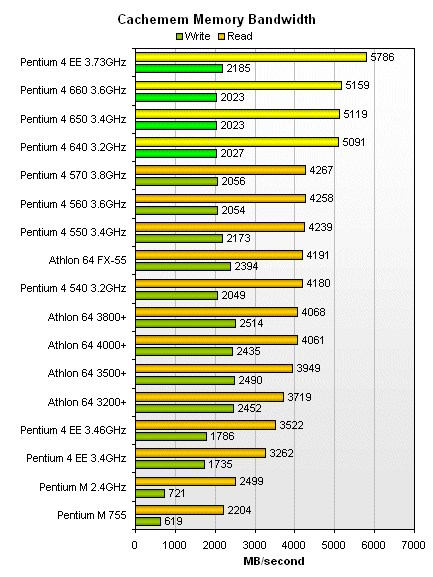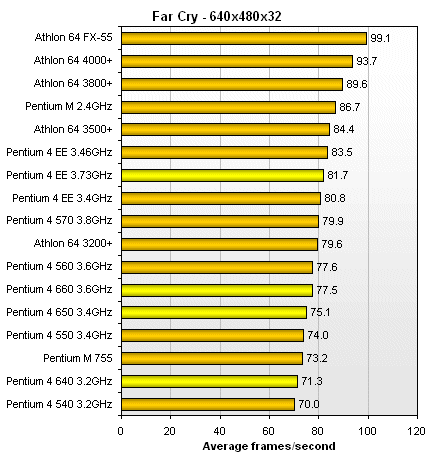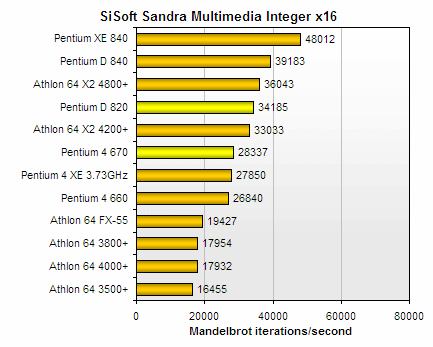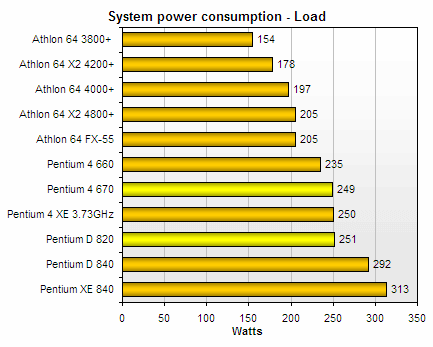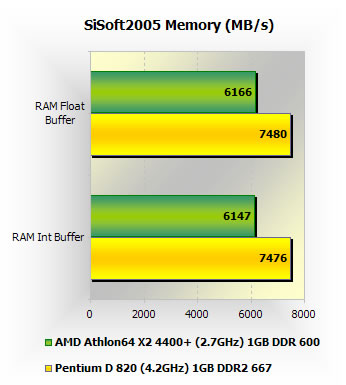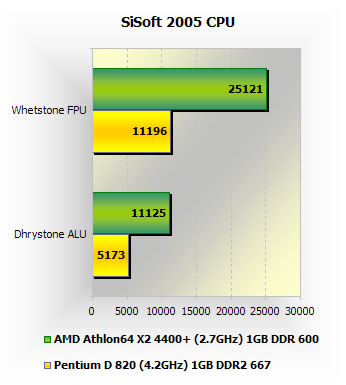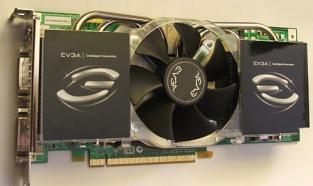INTEL PENTIUM D 820 AND 670 PROCESSORS REVIEW BENCHMARK OVERCLOCKING
![]()
|
|
 |
||||||||||||||||||||||||||||||||||||||||||||||||||||||||||||||||||||||||||||||||||||
| Posted:2006-05-18 By hardware review Number of View:29864 |
|||||||||||||||||||||||||||||||||||||||||||||||||||||||||||||||||||||||||||||||||||||
By :hardware review Posted:2006-05-18
Intel Pentium D 820 and 670 processors Review Benchmark OverclockingIT'S THE GEEKY equivalent of a conversation that most guys would have about a Maxim girl versus the Olsen twins. Would you rather have a single, very fast CPU or a pair of somewhat slower processors? That's a tough question, and it's precisely the one that Intel has prompted by releasing a couple of new CPUs today, the Pentium D 820 and the Pentium 4 670. The P4 670 is the fastest single Pentium 4 processor ever released, running at nearly 4GHz. The Pentium D 820, meanwhile,
runs a full gigahertz slower, but it has two complete Pentium 4-style CPU cores onboard for a very nice price.
Two new Pentiums roll out
The Pentium D 820 (left) and Pentium 4 670 (right)
The Pentium 4 670 is arguably the last of an old guard, a CPU intended to extract maximum performance out of a single processor core. The P4 670 extends the familiar Pentium 4 600 series one more speed grade, to 3.8GHz, and like the rest of the 600 series, the P4 670 packs 2MB of onboard cache to further improve performance. For the privilege of owning a CPU that runs at this dizzying speed, you'll have to pay something close to Intel's list price of $851.
The cores on the Pentium D 820 pulse along at a relatively leisurely pace of 2.8GHz, but there are two of 'em, so its overall performance in multithreaded applications or when multitasking may be superior to a single-core CPU. We've already reviewed the Extreme Edition of Intel's dual-core desktop chip, code-named Smithfield. The Pentium D is a de-tuned version of the Smithfield core that's had its Hyper-Threading capabilities disabled and its clock speed dialed back a few notches to 2.8GHz. In fact, its clock speed is sufficiently slow that Intel apparently saw no need for the 820 to have power management features like Enhanced Speedstep, the C1E halt state, or TM2 thermal throttling. Other recent Pentium desktop processors run at 2.8GHz when throttled back, and the Pentium D 820 is already there. The real virtue of the Pentium D 820 isn't just its dual processor cores, though; it's the price. At only $241, the Pentium D 820 signals that Intel is dead serious about bringing dual-core CPUs to desktop PCs. In fact, the Pentium D's price is low enough to shake up the whole CPU market. Its arrival presents consumers with a series of stark choices between single-core and dual-core processors at roughly comparable prices. That fact, combined with the proliferation of very different model numbering systems from AMD and Intel, has made head-to-head competitive comparisons of CPUs quite a bit trickier than in the past. Freed from the constraints of model number-clock speed comparisons, Intel and AMD have priced their CPUs at points that don't entirely correspond to one another. I've made an attempt, in the table below, to classify competing CPUs in a reasonably direct manner, but I may have only succeeded in illustrating the problem.
That's official pricing on the Pentium D line, by the way. You can see the trouble. Identifying a direct competitor for some of these models, like the Pentium D 830 or the Athlon 64 4000+, is downright befuddling. Fortunately, the two processors we're reviewing here line up fairly directly against the competition. The Pentium 4 670 is priced pretty close to the Athlon 64 FX-55, and the Pentium D 820 just undercuts the Athlon 64 3500+ by $31. That means, of course, that the Pentium D 820's two somewhat pokey cores will do battle with a relatively quick single-core competitor from AMD. This is what I meant by stark choices. AMD doesn't offer a low-end dual-core processor and apparently doesn't plan to do so in the near future. For many single-threaded tasks, one of the Pentium D 820's 2.8GHz cores should be sufficient, but it's hardly quick by current standards—especially when you consider that the long pipeline of the Prescott/Smithfield cores means lower clock-for-clock performance. Intel also offers the Pentium 4 640 at the same basic price, but there's no way a single-core Pentium 4 at 3.2GHz can match the Pentium D 820 overall. I'm getting ahead of myself, though. We'll let the benchmarks tell that tale.
Intel's D95GTP motherboard sports a VGA port and a single PCI-E x1 slot
The 945 series' ability to support DDR2 667 memory may be most beneficial to the performance of the 945G, whose built-in graphics core will have access more memory bandwidth. In the 945G, Intel has massaged the GMA 900 graphics core from the 915G and given it a new name, the GMA 950. The GMA 950 still has a four-pipe design, but clock speeds are up from 333MHz to 400MHz. These tweaks are sufficient for Intel to claim a 100% performance improvement over the GMA 900 in 3DMark05. The GMA 950 also adds the
ability to connect to a media expansion card, useful for such things as adding a TV tuner to one's system. (The 945P lists for $38 in quantities of 1000, and list price on the 945G in 1K quantities is $42. So the price of a GMA 950 is effective $4. That, folks, is how Intel got the be the world's #1 graphics supplier in terms of volume.)
The other end of the chipset equation has changed, too, with the introduction of Intel's ICH7 and ICH7R south bridge chips. The ICH7 series has two more PCI Express lanes than the ICH6, bringing the total up to six. Both ICH7 chips also support Serial ATA's new 300MB/s transfer rates (or 3Gb/s, if you must), but only the ICH7R has Intel's Matrix Storage. The Matrix Storage package includes RAID capabilities, new RAID levels 5 and 10, and support for the AHCI specification. Without AHCI, the non-R version of the ICH7 will be devoid of support for Native Command Queuing (NCQ) and hot-plugging of devices. For that reason, I'd expect even some mid-range 945P-based motherboards to use the ICH7R, as Intel's D945GTP does. Review Intel Pentium D 820 and 670 notes
Also, we have included results for the Pentium D 840 in our testing, which we obtained by disabling Hyper-Threading on our Extreme Edition 840. Since the Pentium D 840 is just an Extreme Edition 840 sans HT, the numbers should be valid. Similarly, the Athlon 64 3500+ scores you'll see in the following pages were obtained by underclocking an Athlon 64 3800+ (with the new "Venice" core) to 2.2GHz. The performance should be identical to a "real" 3500+. Our testing methods
Our test systems were configured like so: What's new
Speaking of which, the Pentium 4 3.73GHz Extreme Edition is quite a change from the 3.46GHz model. This new Extreme Edition is based on the same Prescott-derived CPU core as the 600 series, while previous Extremes were based on the pre-Prescott "Gallatin" core. That means the new Extreme Edition now has a longer, 31-stage main pipeline and lower clock-for-clock performance. The old EE's L3 cache is gone by the wayside, replaced by the beefy 2MB of L2 cache in this new core. The new EE can also do the 64-bit dance, but it doesn't have the fancy power management or enhanced halt state that the 600 series does. The EE 3.73GHz ought to outperform the 600 series thanks to its 1066MHz bus and higher clock speed, but whether it can outperform the EE 3.46GHz is another question.
Benchmark results
Memory performance
Doom 3 Benchmark
Far Cry benchmark
Far Cry barely notices the extra cache at all. Unreal Tournament 2004 benchmark
UT2004 doesn't seem to care much for the additional cache, either, and the new Prescott-based Extreme Edition has trouble catching up to the old one here. However, could the picture change during actual gameplay? Some folks from Intel suggested to us that we should consider testing gameplay performance with the FRAPS frame rate capture program instead of relying on an in-game benchmarking function. The suggestion makes some sense, because timedemo playback tools don't always use every aspect of the game engine, such as physics, A.I., and user input routines. I tried using FRAPS with a couple of games, including Doom 3 and Rome: Total War, but frame rate caps in those games prevented us from being able to show meaningful performance differences between different processors. UT2004, which is very much a CPU-bound game, was a different story. The results below are averaged from five different 150-second gaming sessions played on the same Onslaught map as in our timedemo above, ONS-Torlan. I was playing against computer-controlled bots, so UT2004's A.I. was working overtime. 3DMark05 benchmark
Finally, we have a benchmark that seems to appreciate the additional cache! 3DMark puts it to good use, bolstering the P4 660 and EE 3.73GHz to the top ranks of its overall CPU index. Video encoding and editing
XMPEG DivX video encoding
SiSoft Sandra Benchmark
This benchmark generates a picture (640x480) of the well-known Mandelbrot fractal, using 255 iterations for each data pixel, in 32 colours. It is a real-life benchmark rather than a synthetic benchmark, designed to show the improvements MMX/Enhanced, 3DNow!/Enhanced, SSE(2) bring to such an algorithm. We're using the 64-bit port of Sandra. The "Integer x16" version of this test uses integer numbers to simulate floating-point math. The floating-point version of the benchmark takes advantage of SSE2 to process up to eight Mandelbrot iterations at once.
Power consumption
The graphs below have results for "power management" and "no power management." That deserves some explanation. By "power management," we mean SpeedStep or Cool'n'Quiet. (In the case of the Pentium 4 600-series processors and the Pentium D 840 and Pentium XE 840 CPUs, the C1E halt state is always active, even in the "no power management" tests.) Sadly, the beta BIOS for our Asus A8N-SLI Deluxe mobo wouldn't support Cool'n'Quiet on the Athlon 64 X2 processors. AMD says all of its dual-core chips will support power management once the proper BIOS support becomes available. The Pentium D 820 doesn't support power management, as we've noted.
Interestingly enough, the Pentium D 820's pair of 2.8GHz cores consume almost exactly as much power under load as the Pentium 4 670's single 3.8GHz core. This is one of the main reasons why Intel is moving away from higher clock speeds towards multi-core CPUs. We've already seen that the Pentium D 820 can often outperform the P4 670 in multithreaded applications, though they share the same basic power needs. Overclocking Intel Pentium D 820Test System Specs Processors: The Athlon 64 X2 4400+ is default clocked at 2.2GHz and features a 2MB L2 Cache, 1MB per core. The Pentium D 820 is clocked slightly higher at 2.8GHz and also features a 2MB L2 Cache. The Athlon 64 X2 4400+ was overclocked to 2.7GHz (11x locked multiplier). The Pentium D 820 was overclocked to an impressive frequency of 4.2GHz, using a 300MHz FSB (14x multiplier), making it 1.5GHz faster than the Athlon X2. overclocking result
Conclusion of our reviewI sure wish the Pentium D 820 supported lower multipliers for use with Speedstep, though. There's no good reason why this CPU should consume as much power at idle as it does. he Pentium 4 670 is, I think, a good example of why the single-core approach wasn't working so well for Intel. Despite its high clock speed, the P4 670 struggles in some single-threaded applications, particularly games. The comparably priced Athlon 64 FX-55 is much faster, and so is the much cheaper Athlon 64 3500+. Multithreaded apps do take advantage of Hyper-Threading and make the P4 670 more competitive—perhaps on par with the Athlon 64 FX-55 overall when multiple threads are in use. Even so, a Pentium 4 670-based system consumes about 45 more watts under load than an FX-55 system. Intel has managed to tame the Prescott core's heat and power needs somewhat through power management schemes and better manufacturing, but it's still rather hungry when going full tilt.The Pentium D 820 typifies Intel's new approach, which looks very appealing given the numbers we've seen here today. In multithreaded applications, the Pentium D 820 races by the Athlon 64 3500+, which is a more expensive CPU. In fact, the Pentium D 820 frequently outperforms the Athlon 64 FX-55 and the Pentium 4 670, and our Pentium D system consumes no more power under load than our Pentium 4 670 rig. Still, Pentium D 820's performance does present some rather bold contrasts. It's the slowest CPU in the pack whenever we throw a single-threaded test at it. The 820's gaming performance especially raises some red flags for us, as we've noted. Eventually, games will most likely make the conversion to multithreading, but in the interim, I worry that the newest, most intensive game engines may not run terribly well on a Pentium D at 2.8GHz. Many games will work just fine, no doubt, but those that use lots of AI or physics may be a strain. Hard-core gamers will want to stay away, as will others who extensively use one single-threaded application at a time. The Athlon 64 3500+ is the better choice for them.
we would be happy to answer for your question . if you have suggestion or comment
regarding this review our support would be glad to help just join our forum and ask u will get the best answer
to discuss check our forum section :-) RATE THIS REVIEW | |||||||||||||||||||||||||||||||||||||||||||||||||||||||||||||||||||||||||||||||||||||
![]()

Intel Pentium D 820 and 670 processors Review Benchmark Overclocking
Intel Pentium D 820 and 670 processors Review Benchmark Overclocking


7600gt review
7600gt is the middle card range.
We already benchmarked this video card and found that ...

 geforce 8800gtx and 8800gts
geforce 8800gtx and 8800gts  Xtreview software download Section
Xtreview software download Section  AMD TURION 64 X2 REVIEW
AMD TURION 64 X2 REVIEW  INTEL PENTIUM D 920 , INTEL PENTIUM D 930
INTEL PENTIUM D 920 , INTEL PENTIUM D 930  6800XT REVIEW
6800XT REVIEW  computer hardware REVIEW
computer hardware REVIEW  INTEL CONROE CORE DUO 2 REVIEW VS AMD AM2
INTEL CONROE CORE DUO 2 REVIEW VS AMD AM2  INTEL PENTIUM D 805 INTEL D805
INTEL PENTIUM D 805 INTEL D805  Free desktop wallpaper
Free desktop wallpaper  online fighting game
online fighting game  Xtreview price comparison center
Xtreview price comparison center 

- The new version of GPU-Z finally kills the belief in the miracle of Vega transformation
- The motherboard manufacturer confirms the characteristics of the processors Coffee Lake
- We are looking for copper coolers on NVIDIA Volta computing accelerators
- Unofficially about Intels plans to release 300-series chipset
- The Japanese representation of AMD offered monetary compensation to the first buyers of Ryzen Threadripper
- This year will not be released more than 45 million motherboards
- TSMC denies the presentation of charges from the antimonopoly authorities
- Radeon RX Vega 64 at frequencies 1802-1000 MHz updated the record GPUPI 1B
- AMD itself would like to believe that mobile processors Ryzen have already been released
- AMD Vega 20 will find application in accelerating computations
- Pre-orders for new iPhone start next week
- Radeon RX Vega 57, 58 and 59: the wonders of transformation
- ASML starts commercial delivery of EUV-scanners
- The older Skylake processors with a free multiplier are removed from production
- Meizu will release Android-smartphone based on Helio P40
- AMD Bristol Ridge processors are also available in American retail
- The fate of Toshiba Memory can be solved to the next environment
- duo GeForce GTX 1080 Ti in GPUPI 1B at frequencies of 2480-10320 MHz
- New Kentsfield overclocking record up to 5204 MHz
- Lenovo released Android-smartphone K8



computer news computer parts review Old Forum Downloads New Forum Login Join Articles terms Hardware blog Sitemap Get Freebies
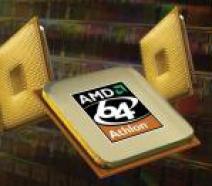
 ]
]
